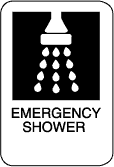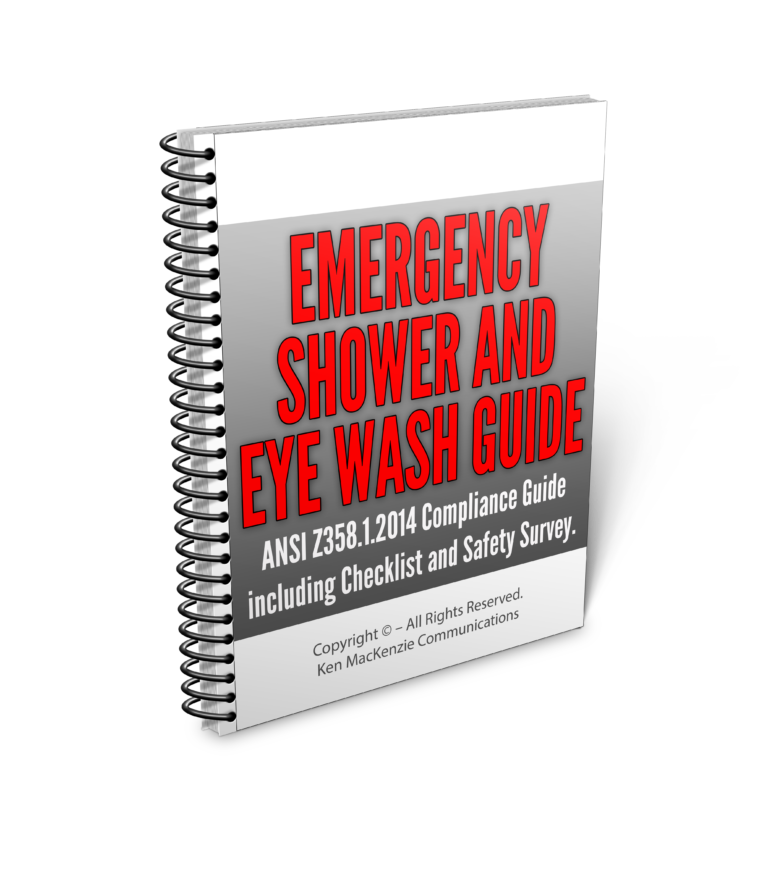Table of Contents
Emergency shower location and Eye Wash Location
 The emergency shower location as well as any eye wash location must be installed within 10 seconds walking time from the location of a hazard.
The emergency shower location as well as any eye wash location must be installed within 10 seconds walking time from the location of a hazard.
How far is that ? According to the revised Appendix, ANSI Z358.1 2014, ten (10) seconds is aproximately 55 feet.
In the workplace, emergency showers and eyewash facilities are used to provide immediate decontamination if workers are exposed to hazardous chemicals, flying particles, or are injured in a fire.
This emergency shower location page will help you decide on the most suitable location for your emergency decontamination station, because the first 10-15 seconds after a chemical exposure incident or burn is of critical importance. W
The location of the your decontamination equipment could be the difference between complete recovery, permanent blindness or a fatal injury.
The emergency shower and eye wash equipment must be installed
on the same level as the hazard !
The emergency shower equipment must be installed on the same level as the hazard and accessing the emergency eye wash and/or emergency shower equipment should NOT require going up or down stairs or ramps.
The path of travel from the hazard to the equipment should be free of obstructions and as straight as possible. Remember, doors are a concern and may hinder a user accessing safety shower emergency equipment. A
In order to be compliant — a worker must NOT have to do any of the following to reach the emergency decontamination equipment:
Climb up or down a ladder
Open a cupboard, door, or gate
Get past a partition or barrier
Unlock something
Move items out of the way
Use stairs
Emergency eye wash location and emergency shower location equipment should be placed adjacent to Extreme Hazards
 Of course, there are circumstances where these guidelines may not be adequate such as where workers are handling particularly strong acids, caustics or other materials where the consequences of a spill would be very serious.
Of course, there are circumstances where these guidelines may not be adequate such as where workers are handling particularly strong acids, caustics or other materials where the consequences of a spill would be very serious.
In these cases, emergency eye wash and/or emergency shower equipment should be installed immediately adjacent to the hazard.
Laboratory Situations:
Laboratory environments also require special consideration as it’s common in many laboratories to install emergency shower equipment in corridors or hallways outside of the lab room.
This may possibly satisfy the provisions of the Standard but still not provide workers with immediate access to emergency equipment. In these cases, it is recommended installing combination eyewash and drench hose units at lab sinks.
Here’s an emergency shower drench checklist and an emergency eyewash station checklist.
The Emergency Shower and Eye Wash Guide eBook focuses on emergency eyewash and shower equipment, and has been written to help you select and install an emergency wash station that will best serve the unique hazards present at your own worksite.
We’ve written this document so it’s easy-to-read and contains the practical information you need to understand your compliance obligations; more specifically: – the Importance of conducting a risk assessment before selecting and installing emergency wash equipment – Critical differences between eyewash equipment and emergency showers Installation essentials including the ’10 second rule’ – Mandatory signage, tagging, and testing specifications – Ongoing training recommendations for workers and site personnel.
It is important to remember that eyewash stations and emergency showers are first aid treatment facilities and NOT hazard control measures.
As an Amazon Associate I earn from qualifying purchases. EmergencyShowerSystems.com is a participant in the Amazon Services LLC Associates Program, an affiliate advertising program. It’s designed to provide a means for sites to earn advertising fees by advertising and linking to Amazon.com.
Links on this Emergency Shower Location page are sponsored affiliate links. The owner makes commission if you buy after clicking these links. The owner is not a bona-fide user of this product. However, he has thoroughly researched it and provided a personal opinion only. This disclosure is in accordance with the Federal Trade Commission’s 16 CFR, Part 255: “Guides Concerning the Use of Endorsements and Testimonials in Advertising.”


